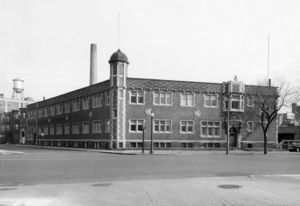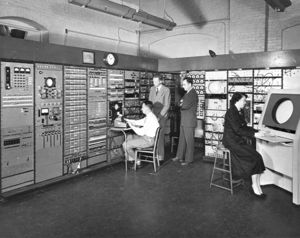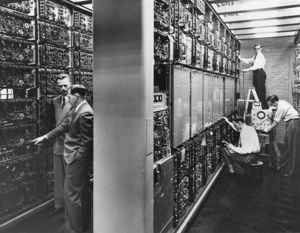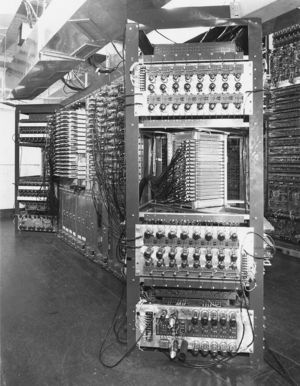Milestones:Whirlwind Computer, 1944-59: Difference between revisions
No edit summary |
m (Text replace - "[[Category:Computers_and_information_processing" to "[[Category:Computing and electronics") |
||
| Line 43: | Line 43: | ||
MIT Cambridge, MA</googlemap> | MIT Cambridge, MA</googlemap> | ||
[[Category: | [[Category:Computing and electronics|{{PAGENAME}}]] | ||
[[Category:Memory|{{PAGENAME}}]] | [[Category:Memory|{{PAGENAME}}]] | ||
[[Category:Random_access_memory|{{PAGENAME}}]] | [[Category:Random_access_memory|{{PAGENAME}}]] | ||
Revision as of 16:16, 22 July 2014
Whirlwind Computer, 1944 - 1959
The Whirlwind computer was developed at 211 Massachusetts Avenue by the Massachusetts Institute of Technology. It was the first real-time high-speed digital computer using random-access magnetic-core memory. Whirlwind featured outputs displayed on a CRT, and a light pen to write data on the screen. Whirlwindʼs success led to the United States Air Forceʼs Semi Automatic Ground Environment - SAGE - system and to many business computers and minicomputers.
The plaque may be viewed at 211 Massachusetts Avenue, Cambridge, Massachusetts, USA.
Summary: The Whirlwind computer was developed at the Massachusetts Institute of Technology (MIT) between 1945 and 1952 in a project directed by Jay Forrester. The project was first carried out in the Servomechanisms Laboratory. Later it separated to become the Digital Computer Laboratory and Lincoln Laboratory, Division 6, and testing continued through 1958. Jay Forrester served as director of both laboratories until 1956, and Robert Everett as associate director, then director. A key part of the Whirlwind design was the high-speed and highly reliable magnetic core memory for the computer storage system, replacing electrostatic storage tubes. Jay Forrester was issued a patent for the magnetic core memory, and it was used successfully and widely in large and small computers.
History: The development of Whirlwind, one of the first large-scale high-speed computers, began during World War II as part of a research project to develop a universal flight trainer that would simulate flight (the Aircraft Stability and Control Analyzer project). It was initiated by the Office of Naval Research and began at the MIT Servomechanisms Laboratory in 1944. Eventually the focus of the grant, a flight simulator, using an analog computer, changed to developing a high-speed digital computer. While building the computer, researcher Jay W. Forrester discovered random-access, coincident-current magnetic storage, which became the standard memory device for digital computers. Prior to Forrester's discovery, electrostatic storage tubes were used. The introduction and change to magnetic core memory provided high levels of speed and of reliability. By late 1951, the Whirlwind computer was operational and made available for scientific and military research. Unclassified research projects using the Whirlwind computer were managed by the Digital Computer Lab staff on the MIT campus, where Whirlwind occupied the Barta Building (N42), which had been acquired in 1947 to provide sufficient space for the computer as it was designed and constructed. In 1952 staff working on classified projects left to be part of the newly organized Lincoln Laboratory off campus, to form Division 6, Digital Computer Division. Although their projects were classified, the Whirlwind computer itself was not, and remained in the Barta Building. Jay Forrester served as director of the Digital Computer Laboratory and Division 6, Lincoln Laboratory until 1956, when he became a member of the MIT faculty pursuing interests in system dynamics in management. Robert Everett served as associate director of both labs until he succeeded Forrester as director. The U.S. Air Force provided substantial financial support for Whirlwind applications and Whirlwind was a key component in the design of the Air Force's SAGE (Semi-Automatic Ground Environment) air defense system in the 1950s. Whirlwind computer was shut down on May 29, 1959. It was disassembled and moved out of the Barta building in the spring of 1960.
Jay Forrester received a patent for magnetic core memory. IEEE GHN explains why: “The magnetic-core, a wire mesh of ferrite rings and metal wire, created a location where binary information could be recorded and retrieved magnetically. The ability to pinpoint specific intersections or addresses within the core rings, from which information could be stored and then recalled at random, created an unparalleled innovation in computing. The computer’s central processing unit and its memory of stored data, procedures and programs, could now be operated interactively. This interactivity boiled down to one major innovative gain: speed. Random-access memory was born.”
Further Reading
1. The complete source of documentation for the Whirlwind project during the period 1944 to 1959 is housed at MIT Archives and Special Collection MC 665. The finding aid to the collection is available on-line: Collection MC 665.
2. On-line references available in September 2011 http://wapedia.mobi/en/Whirlwind_(computer)
3. Reference Books
Redmond, Kent, and Thomas Smith. Project Whirlwind: The History of a Pioneer Computer. Bedford, MA: Digital Press, 1980.
Redmond, Kent, and Thomas Smith. From Whirlwind to MITRE, the R & D Story of the SAGE Air Defense Computer. Cambridge: MIT Press, 2000.
4. Additional images can be found in the Project Whirlwind Photo Archives.
Letter from the site owner giving permission to place IEEE milestone plaque on the property
Proposal and Nomination
Milestone-Proposal:Whirlwind Computer
Milestone-Nomination:Whirlwind Computer
<googlemap version="0.9" lat="42.361244" lon="-71.096663" zoom="10" width="300" height="250" controls="small"> 42.361244, -71.096663, MIT Cambridge, MA</googlemap>



